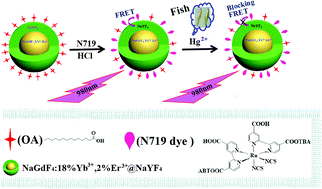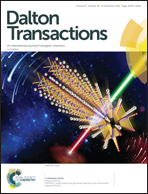Upconversion core/shell nanoparticles with lowered surface quenching for fluorescence detection of Hg2+ ions†
Abstract
In this study, we reported a fluorescent nanoprobe assembled with upconversion core/shell nanoparticles and a chromophore ruthenium complex (N719@UCNPs). Functional groups (NCS) of the ruthenium complex N719 could react with Hg2+, which made N719 lose the efficacy in quenching the fluorescence of upconversion nanoparticles (UCNPs) and resulted in the recovery of the fluorescence intensity of UCNPs eventually. This fluorescent nanoprobe could provide a rapid and efficient detection of Hg2+ ions in vivo based on the fluorescence resonance energy transfer (FRET) between UCNPs and N719, and a detection limit of 0.1 μg mL−1 can be achieved based on this nanoprobe. It's worth mentioning that, compared with bare core upconversion nanoparticles, the core/shell UCNPs could greatly reduce the surface quenching of the fluorescence induced by solvents instead of N719, thus leading to the enhancement of signal-to-noise ratios. Moreover, the excitation of core/shell UCNPs requires a much lower power (0.06 W cm−2) than that of bare cores, which is beneficial for reducing the decomposition of N719 to stabilize the FRET processes.



 Please wait while we load your content...
Please wait while we load your content...